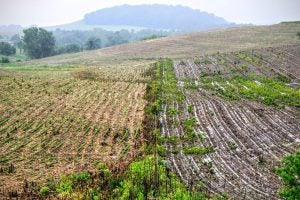A new U.S. Department of Agriculture report shows conservation trends like the use of no-till, crop rotations, more efficient irrigation methods, and advanced technologies have climbed in recent years.
The report from USDA’s Natural Resources Conservation Service demonstrates progress made through voluntary conservation over a 10-year period. Findings from the report will inform future conservation strategies, including USDA’s efforts to tackle the climate crisis.
The “Conservation Practices on Cultivated Cropland: A Comparison of CEAP I and CEAP II Survey Data and Modeling” was developed by USDA’s Conservation Effects Assessment Project (CEAP). It found significant gains for soil health and soil carbon storage, while also identifying areas where additional and targeted nutrient management strategies are needed.
Key findings include:
- Farmers increasingly adopted advanced technology, including enhanced-efficiency fertilizers and variable rate fertilization to improve efficiency, assist agricultural economies and benefit the environment.
- More efficient conservation tillage systems, particularly no-till, became the dominant form of tillage, improving soil health and reducing fuel use.
- Use of structural practices increased, largely in combination with conservation tillage as farmers increasingly integrated conservation treatments to gain efficiencies. Structural practices include terraces, filter and buffer strips, grassed waterways and field borders.
- Irrigation expanded in more humid areas, and as irrigators shifted to more efficient systems and improved water management strategies, per-acre water application rates decreased by 19% and withdrawals by 7 million-acre-feet.
- Nearly 70% of cultivated cropland had conservation crop rotations, and 28% had high-biomass conservation crop rotations.
Because of this increased conservation, the report estimates:
- Average annual water (sheet and rill) and wind erosion dropped by 70 million and 94 million tons, respectively, and edge-of-field sediment loss declined by 74 million tons.
- Nearly 26 million additional acres of cultivated cropland were gaining soil carbon, and carbon gains on all cultivated cropland increased by over 8.8 million tons per year.
- Nitrogen and phosphorus losses through surface runoff declined by 3% and 6%, respectively.
- Average annual fuel use dropped by 110 million gallons of diesel fuel equivalents, avoiding associated greenhouse gas emissions of nearly 1.2 million tons of carbon dioxide equivalents.

The report also revealed that cropping patterns have changed over the years in response to climate, policy, trade, renewable energy and prices, presenting a nutrient management challenge. Improving the timing and application method of nutrients can allow production demands to be met while reducing the impacts of crop production on the environment.
For this report, farmer survey data was collected from 2003-2006 and again from 2013-2016. NRCS evaluates conservation practice adoption through the CEAP Cropland Assessment, using a combination of farmer surveys, land use and soils information, along with resource models
You can download the full report here or a four-page summary of findings on the USDA website.
“This latest CEAP report show that farmers have done an outstanding job over the years in using innovative conservation strategies that help mitigate climate change,” James Bauchert, NRCS Acting State Conservationist in Wyoming, “But we have more work to do. Reports like this one help us better understand conservation approaches and make improvements to increase positive impacts. This report will help steer our conservation efforts well into the future to help us adapt to changing trends in production, climate, and technology.”


